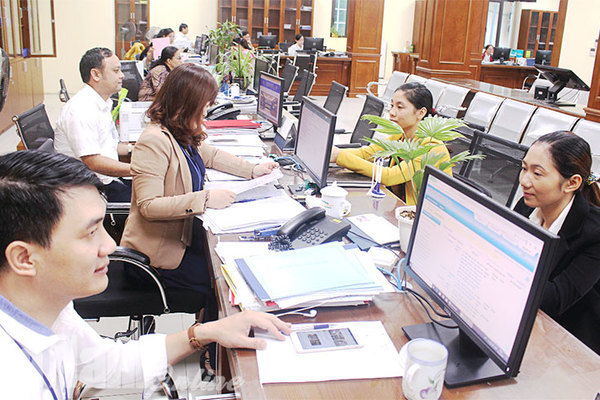 |
|
|
Public administration reform (PAR) is a process for all stakeholders from the public and non-public sectors. In the past decade, there were many systems to monitor the performance of the government apparatus at central and local levels, managed by organizations, associations, and non-governmental organizations, contributing to a push to improve public service efficiency.
Attempts to increase rankings
The chart below shows the change from zero to many measures to help government agencies at all levels examine themselves over time.
The indexes contributing to the change of local public service governance and provision include the Provincial Competitiveness Index (PCI) of the Vietnam Chamber of Commerce and Industry (VCCI), the Provincial Governance and Public Administration Performance Index (PAPI) of UNDP and its partners in Vietnam.
Timeline of public performance evaluation indicators
In addition, many international indicators are contributing to promoting innovation in Vietnam. The country is making great efforts to increase its position in international rankings in the spirit of Resolution 02/NQ-CP on performing main tasks and solutions to improve the business environment and enhance national competitiveness in 2020.
Indicators such as the UN's e-government index, the UNDP's human development index, and the World Bank's business environment are being periodically monitored by Vietnam.
Facing the requirement to strengthen national competitiveness and the task of realizing the goals set out in the state administrative reform program, the administrative apparatus, especially grassroots authorities, are under increasing pressure. Meanwhile, the key element of the apparatus is the contingent of cadres, civil servants and public employees.
In order to serve people and businesses with integrity and professionalism, the organization of public service personnel needs to be done scientifically, employees should be recruited based on actual capacity, with assignment records and be assessed in many dimensions, and inspections of the public service should be done fairly.
Some indicators measure performance of government apparatus
However, based on statistics of the PCI, PAPI and Provincial Anti-Corruption Assessment (PACA) indicators, harassment and raising difficulties toward businesses and citizens by public employees at administrative agencies is still a problem. It is still a fact that there are many doors and intermediaries at administrative agencies that businesses and people have to pass. According to the PAPI index, in the assessment of the effectiveness of corruption control, fairness in recruitment of employees in the public sector was rated at the lowest level.
Lack of KPI for efficiency of public services
According to PAPI surveys, the positions that must rely most heavily on relationships to get at commune-level government agencies are the staff who perform land-related administrative procedures. Other positions such as judicial officers, teachers at public primary schools, and staff of People's Committees of communes, wards and towns also require relationships to be recruited.
In that context, the promise of building a contingent of enthusiastic, “talented” civil servants has not been realized after 20 years.
In addition, public service inspection seems to be very formal. Regulations on inspection and examination of public services do not favor unexpected inspection and examination. If only periodic inspections are launched, state agencies have time to prepare thoroughly for the inspection, so it is difficult to accurately assess the performance of daily public service activities of cadres and civil servants.
Meanwhile, the implementation of job positions and the application of assignment records to cadres and civil servants by law were suspended after this mechanism was trialed at a number of ministries, sectors and localities without unknown causes.
So far, there is still no Key Performance Indicators (KPIs) for civil servants at each level and in each sector. The civil service system seems to lag far behind in the application of effective HR management solutions in comparison with the private sector.
No need to streamline commune-level payroll
With a population of more than 96 million, associated with commune, ward and town authorities, the contingent of communal cadres and civil servants are under pressure to serve the people, but they are not given adequate attention. These employees are not promptly informed with necessary information, and have not been properly trained to implement policies and law enforcement at the grassroots level.
Many directions and instructions of provincial authorities on improving operational efficiency to improve public administrative service indicators do not reach civil servants at commune level. For example, at a meeting on the PAPI survey, with the participation of more than 700 civil servants who are chairman and vice-chairman of communes/wards/towns in Ho Chi Minh City, only five people raised their hands after they were asked whether they knew about the PAPI index. Only one of them knew about the Satisfaction Index of Public Administrative Services (SIPAS) index. None of them knew about sectoral indicators such as the Government Inspectorate's PACA.
There is also a need to reconsider the payroll streamlining. Payroll streamlining is mainly carried out at the grassroots level, where additional civil servants are needed, especially in densely populated provinces home to migrants such as Hanoi, Ho Chi Minh City, Binh Duong and Dong Nai.
The solution suggested for this situation is to localize the demand for public service staff. It is also necessary to separate urban and rural governments to ensure a more appropriate allocation of human resources and budgets based on local conditions.
The payroll streamlining should focus on the intermediate level (districts) and provincial and city levels, not commune, because administrative agencies at this level have to handle many citizen-related tasks.
Do Thanh Huyen (Public Policy Analyst, UNDP Vietnam)